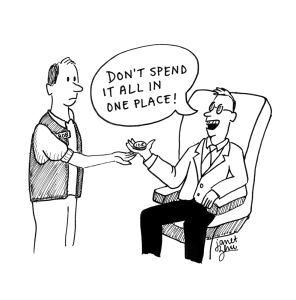
I wasn’t trying to support a family with my minimum wage paycheck from my summer job in a fast food restaurant.
My fellow cashier, Kelsey, however, was. Kelsey’s husband had recently lost his job as a security guard, and she had a 2-month-old son at home to feed. Her story is all too familiar — a member of America’s working poor, she grinds away every day at a job that does not provide her with enough to get by.
While it is true that, according to the Pew Research Center, only 4.7 percent of the nation’s 75.3 million hourly-paid workers make minimum wage, more than half of them are women, who, like Kelsey, could greatly benefit from an increase in the minimum wage — and this statistic does not include those who make only slightly more than minimum wage.
And yet, the federal minimum wage has remained at $7.25 per hour since 2009, falling remarkably short of the standards our peer countries set for their workers.
Perhaps the most egregious consequence of a low minimum wage is a high demand for food stamps, which puts undue pressure not only on the low-wage families that are forced to use them, but also on the government and on taxpayers. Last year alone, $76 billion from the U.S. Treasury went toward filling people’s food stamp cards.
One of those cards belonged to Kelsey, and another belonged to Walmart employee Stephanie Ballam.
In a Marketplace series entitled, “The Secret Life of a Food Stamp,” Krissy Clark reveals the way in which many large corporations doubly benefit from keeping the minimum wage low, spending less on their employees’ salaries and gaining government money when their low-wage workers use food stamps in their stores. Clark reports that when Ballam finishes her shift at a Walmart Supercenter near Columbus, Ohio, she “sometimes picks up a few groceries … then, because she doesn’t earn enough money at her job to make ends meet, she will often pay for the groceries with food stamps.”
By paying workers like Ballam less money, Walmart raked in more than $13 billion in revenue last year from the Supplemental Nutrition Assistance Program. They have even worked food stamps into its business model — Clark also reports that stores stock up on grocery staples whenever SNAP cards are being recharged.
It seems the only group that benefits from keeping minimum wage low is big business. Thus, it makes sense that many large corporations, including Walmart, prefer to keep wages low.
When Seattle recently voted to raise the hourly minimum wage to $15, many opponents of the bill argued that small businesses would suffer while large corporations would easily absorb the shock of higher wages.
However, in the article “Is the Fight for 15 Strangling Small Business?” Leela Yellesetty and Chris Mobley point out that many who assert this point “include representatives of the world’s biggest corporations [who are] using small businesses as a shield,” basing argument not in fact but in fear.
One major fear that grips the American public is a rise in prices. However, in a video entitled “What if Walmart Paid Its Employees More?” economists crunched numbers from Ohio and found that an increase in minimum wage would only raise Walmart prices by 1.4 percent; in other words, a 68-cent box of mac and cheese would become 69 cents.
Opponents of regional and state increases in minimum wage also fear loss of jobs and unemployment. Yet Bloomberg News recently reported that after Washington’s model increase of minimum wage to $15 an hour, the state performed better than the national average in job growth, poverty levels and, unsurprisingly, wage rates.
A grumbling customer once approached me at the register and complained that the high price of her meal was due to a recent increase in California minimum wage from $8 an hour to $9. She griped that California legislators failed to see the “big picture” of the effects of increasing minimum wage.
Much to my supervisor’s chagrin, I pointed out that the “big picture” of rising prices and unemployment and a flagging economy as a result of raising the minimum wage is actually an illusion painted by clawed corporate fingers. The price of her meal had not increased at all from the time when California minimum wage was lower.
The real picture involves a simple solution to an obvious problem; one can see it after spending a summer behind the counter with Kelsey.
 Emma Lux is a freshman in the College. Millennial Voices appears every other Monday at thehoya.com
Emma Lux is a freshman in the College. Millennial Voices appears every other Monday at thehoya.com















